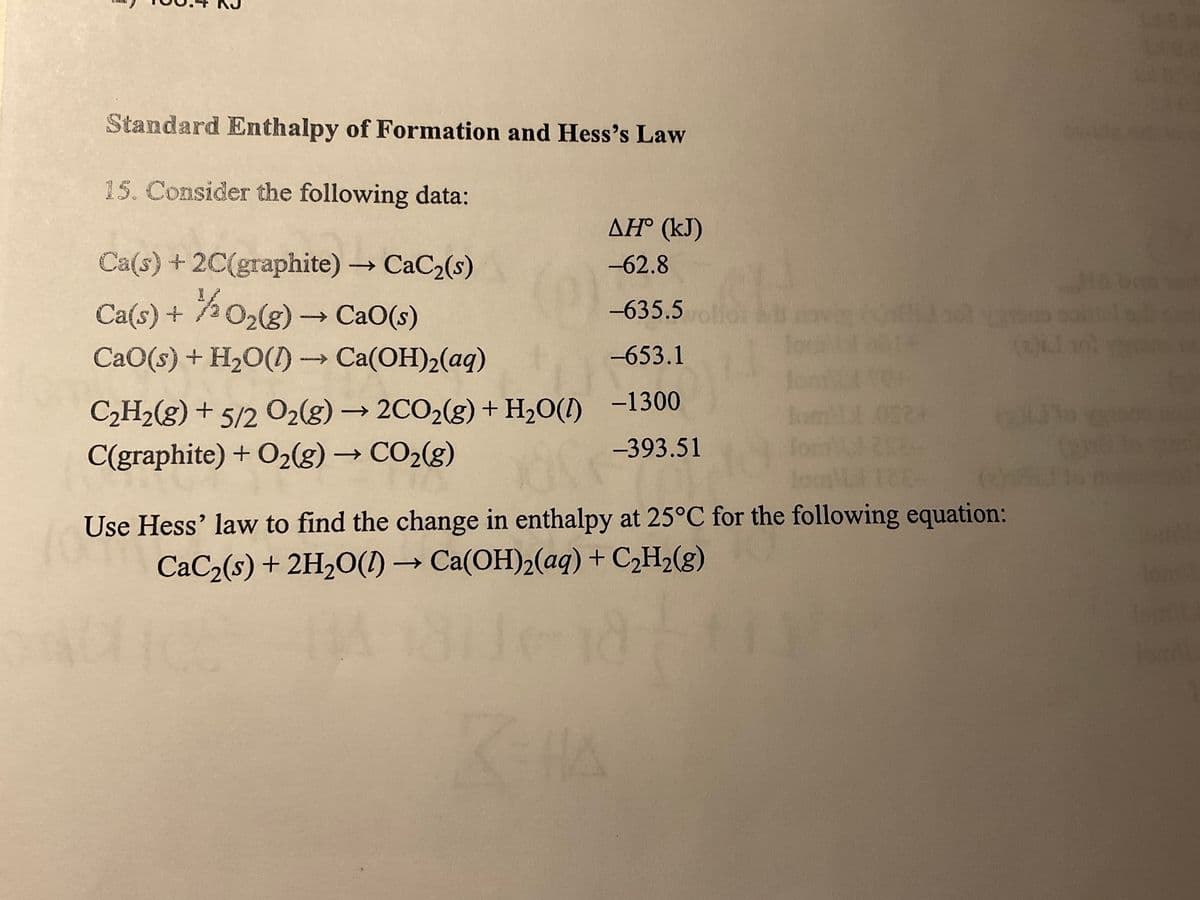Standard Enthalpy of Formation and Hess's Law 15. Consider the following data: ΔΗ° (kJ) -62.8 -635.5 -653.1 C₂H₂(g) + 5/2 O2(g) → 2CO₂(g) + H₂O() -1300 C(graphite) + O2(g) → CO₂(g) -393.51 Ca(s) + 2C(graphite) → CaC₂(s) Ca(s) + 1/2O₂(g) → Cao(s) CaO(s) + H₂O() →→→ Ca(OH)₂(aq) 35.5.6.1 1264 101 1000 Use Hess' law to find the change in enthalpy at 25°C for the following equation: CaC₂(s) + 2H₂O(1)→ Ca(OH)₂(aq) + C₂H₂(g)
Standard Enthalpy of Formation and Hess's Law 15. Consider the following data: ΔΗ° (kJ) -62.8 -635.5 -653.1 C₂H₂(g) + 5/2 O2(g) → 2CO₂(g) + H₂O() -1300 C(graphite) + O2(g) → CO₂(g) -393.51 Ca(s) + 2C(graphite) → CaC₂(s) Ca(s) + 1/2O₂(g) → Cao(s) CaO(s) + H₂O() →→→ Ca(OH)₂(aq) 35.5.6.1 1264 101 1000 Use Hess' law to find the change in enthalpy at 25°C for the following equation: CaC₂(s) + 2H₂O(1)→ Ca(OH)₂(aq) + C₂H₂(g)
Chemistry: The Molecular Science
5th Edition
ISBN:9781285199047
Author:John W. Moore, Conrad L. Stanitski
Publisher:John W. Moore, Conrad L. Stanitski
Chapter4: Energy And Chemical Reactions
Section: Chapter Questions
Problem 83QRT: The reaction enthalpy for oxidation of styrene, C8H8, has been measured by calorimetry. C8H8() + 10...
Related questions
Question
How would you answer this question?

Transcribed Image Text:Standard Enthalpy of Formation and Hess's Law
15. Consider the following data:
Ca(s) + 2C(graphite) → CaC₂(s)
Ca(s) + 1/2O₂(g) →→ CaO(s)
CaO(s) + H₂O(1)→→ Ca(OH)₂(aq)
p
C₂H₂(g) + 5/2 O2(g) → 2CO₂(g) + H₂O(1)
C(graphite) + O₂(g) → CO₂(g)
ΔΗ° (kJ)
-62.8
-635.5
-653.1
-1300
-393.51
K-HA
022+
21000
Use Hess' law to find the change in enthalpy at 25°C for the following equation:
CaC₂(s) + 2H₂O(1)→ Ca(OH)₂(aq) + C₂H₂(g)
141813
116
Toml
Jom!
Expert Solution
Step 1
Hess's law describes that regardless of the multiple stages or steps of a reaction, the total enthalpy change for the reaction is the sum of all changes.
Trending now
This is a popular solution!
Step by step
Solved in 4 steps with 2 images

Follow-up Questions
Read through expert solutions to related follow-up questions below.
Follow-up Question
Can you explain what has been added together in step 3?
Solution
Knowledge Booster
Learn more about
Need a deep-dive on the concept behind this application? Look no further. Learn more about this topic, chemistry and related others by exploring similar questions and additional content below.Recommended textbooks for you

Chemistry: The Molecular Science
Chemistry
ISBN:
9781285199047
Author:
John W. Moore, Conrad L. Stanitski
Publisher:
Cengage Learning

Chemistry: Matter and Change
Chemistry
ISBN:
9780078746376
Author:
Dinah Zike, Laurel Dingrando, Nicholas Hainen, Cheryl Wistrom
Publisher:
Glencoe/McGraw-Hill School Pub Co

Chemistry: Principles and Practice
Chemistry
ISBN:
9780534420123
Author:
Daniel L. Reger, Scott R. Goode, David W. Ball, Edward Mercer
Publisher:
Cengage Learning

Chemistry: The Molecular Science
Chemistry
ISBN:
9781285199047
Author:
John W. Moore, Conrad L. Stanitski
Publisher:
Cengage Learning

Chemistry: Matter and Change
Chemistry
ISBN:
9780078746376
Author:
Dinah Zike, Laurel Dingrando, Nicholas Hainen, Cheryl Wistrom
Publisher:
Glencoe/McGraw-Hill School Pub Co

Chemistry: Principles and Practice
Chemistry
ISBN:
9780534420123
Author:
Daniel L. Reger, Scott R. Goode, David W. Ball, Edward Mercer
Publisher:
Cengage Learning


Chemistry & Chemical Reactivity
Chemistry
ISBN:
9781337399074
Author:
John C. Kotz, Paul M. Treichel, John Townsend, David Treichel
Publisher:
Cengage Learning

Chemistry & Chemical Reactivity
Chemistry
ISBN:
9781133949640
Author:
John C. Kotz, Paul M. Treichel, John Townsend, David Treichel
Publisher:
Cengage Learning